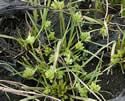Cyperus acuminatus (Tapertip Flatsedge)
| Also known as: | Short-pointed Umbrella-sedge, Taperleaf Flatsedge |
|---|---|
| Genus: | Cyperus |
| Family: | Cyperaceae (Sedge) |
| Life cycle: | annual |
| Origin: | native |
| Status: |
|
| Habitat: | sun; moist to wet; mud flats, sloughs, ephemeral pools in rock outcrops, pond and lake edges |
| Fruiting season: | August - October |
| Plant height: | 2 to 14 inches |
| Wetland Indicator Status: | GP: OBL MW: OBL NCNE: OBL |
| MN county distribution (click map to enlarge): |  |
| National distribution (click map to enlarge): |  |
Pick an image for a larger view. See the glossary for icon descriptions.
Detailed Information
Flower: 


![[photo of spikelet clusters]](/udata/r9ndp23q/pd3/cyperus-acuminatus-836-12-t.jpg) 1 to 4 clusters up to ½ inch across at the tip of the stem, each cluster with 25 to 50 spikelets (flower clusters), occasionally more. The main cluster of spikelets is stalkless and hemispheric in outline, auxiliary clusters are smaller, more oval in outline, on stalks up to about 1½ inch long. At the base of the group of clusters are 3 to 6 leaf-like bracts of varying lengths, V-shaped in cross section, the largest up to 4¾ inches long and erect, the others widely spreading. Spikelets are flattened, lance-oblong in outline, up to about 7mm (¼ inch) long, with 8 to 35 florets, each subtended by a scale. Florets have a single stamen and a 3-parted style. Scales are 1 to 2mm long, lance-oblong, pointed at the tip, with a green to light brown midrib and 2 lateral ribs. The scales are arranged overlapping on opposite sides of the central spikelet stalk (rachilla), the tips slightly spreading outward and straight to slightly curved.
1 to 4 clusters up to ½ inch across at the tip of the stem, each cluster with 25 to 50 spikelets (flower clusters), occasionally more. The main cluster of spikelets is stalkless and hemispheric in outline, auxiliary clusters are smaller, more oval in outline, on stalks up to about 1½ inch long. At the base of the group of clusters are 3 to 6 leaf-like bracts of varying lengths, V-shaped in cross section, the largest up to 4¾ inches long and erect, the others widely spreading. Spikelets are flattened, lance-oblong in outline, up to about 7mm (¼ inch) long, with 8 to 35 florets, each subtended by a scale. Florets have a single stamen and a 3-parted style. Scales are 1 to 2mm long, lance-oblong, pointed at the tip, with a green to light brown midrib and 2 lateral ribs. The scales are arranged overlapping on opposite sides of the central spikelet stalk (rachilla), the tips slightly spreading outward and straight to slightly curved.
Leaves and stems: 


![[photo of maturing plant]](/udata/r9ndp23q/pd3/cyperus-acuminatus-091316-8-t.jpg) Leaves are basal and alternate, typically 2 to 6 per stem near the base, flat to V-shaped in cross-section, 1 to 2(4) mm wide, the longest leaves more or less as long as the flowering stem. Stems are multiple from the base, erect to ascending, 3-sided with rounded angles, mostly smooth, and green to straw-colored. Plants form loose to dense clumps.
Leaves are basal and alternate, typically 2 to 6 per stem near the base, flat to V-shaped in cross-section, 1 to 2(4) mm wide, the longest leaves more or less as long as the flowering stem. Stems are multiple from the base, erect to ascending, 3-sided with rounded angles, mostly smooth, and green to straw-colored. Plants form loose to dense clumps.
Fruit: 
![[photo of spikelet, scales and achene]](/udata/r9ndp23q/grass/cyperus-acuminatus-091416-2-t.jpg) The floral scales mature from green to light reddish-brown to straw-colored. The scales and achenes (seeds) drop off individually when mature, leaving the naked stalk behind. Achenes are .8 to 1.1mm long, brown, 3-sided, elliptic, pointed at both ends, with a short, stalk-like appendage (stipe) at the base.
The floral scales mature from green to light reddish-brown to straw-colored. The scales and achenes (seeds) drop off individually when mature, leaving the naked stalk behind. Achenes are .8 to 1.1mm long, brown, 3-sided, elliptic, pointed at both ends, with a short, stalk-like appendage (stipe) at the base.
Notes:
Cyperus acuminatus is a small flatsedge, rare in Minnesota with fewer than 15 known populations, but is more common to our west and south. Across its range it's found in the disturbed, wet, sandy or muddy shores of lakes, ponds and streams, on mud flats and sloughs. According to the DNR, in Minnesota its preferred habitat appears to be the edges of ephemeral pools in rock outcrops, a rare habitat, and at risk from gravel mining and invasive species as well as destruction from cattle grazing. It was listed as a state Threatened Species in 1996. The 3-ribbed scales (best seen when dry) with slightly spreading tips and dense, rounded clusters are distinctive among Minnesota's Cyperus species. Most similar is Cyperus squarrosus, with which it often grows, and which also has one or more globular clusters and spreading tips on the scales, but its scales are distinctly awned, 7 to 9-veined, more widely spreading, and there are usually fewer spikelets in a cluster than C. acuminatus.
Native Plant Nurseries, Restoration and Landscaping Services ↓
More photos
 Cyperus acuminatus plant
Cyperus acuminatus plant Cyperus acuminatus plants
Cyperus acuminatus plants Cyperus acuminatus plants
Cyperus acuminatus plants Cyperus acuminatus rock outcrop habitat
Cyperus acuminatus rock outcrop habitat Cyperus acuminatus muddy slough habitat
Cyperus acuminatus muddy slough habitat Cyperus acuminatus with Cyperus squarrosus
Cyperus acuminatus with Cyperus squarrosus close-up of spikelet cluster
close-up of spikelet cluster straw-colored late season spikelets
straw-colored late season spikelets Cyperus acuminatus spikelet compared to Cyperus squarrosus
Cyperus acuminatus spikelet compared to Cyperus squarrosus
Photos by K. Chayka taken in Ramsey County. Photos courtesy Peter M. Dziuk taken in Chippewa and Rock counties.
Comments
Have you seen this plant in Minnesota, or have any other comments about it?






